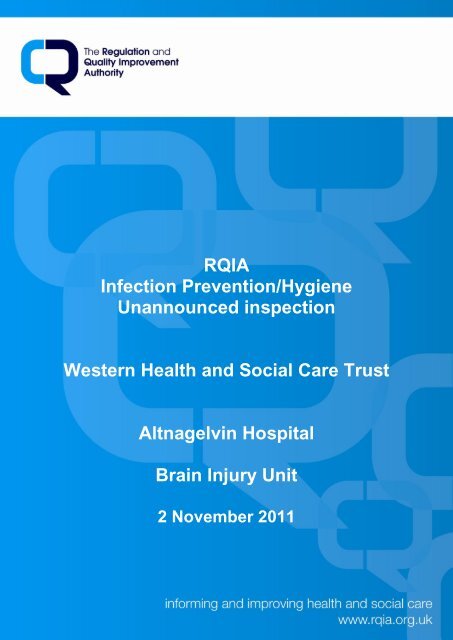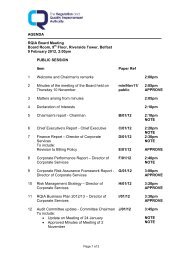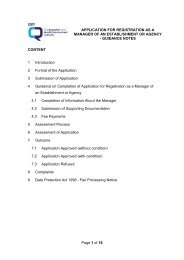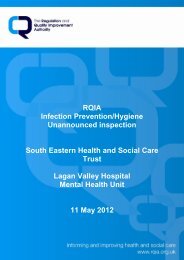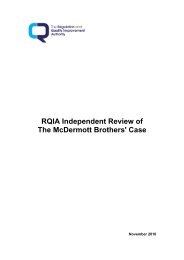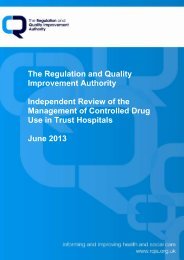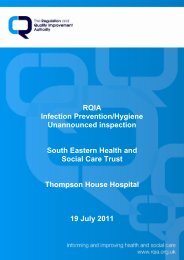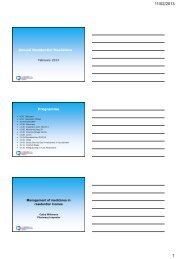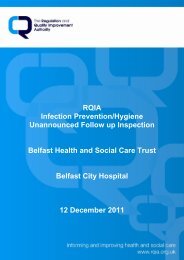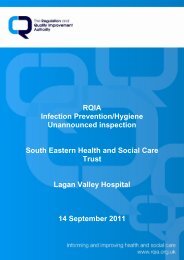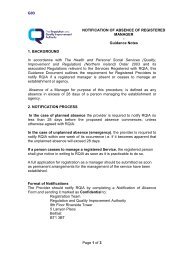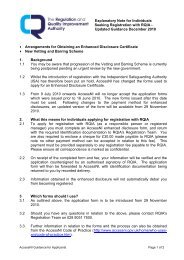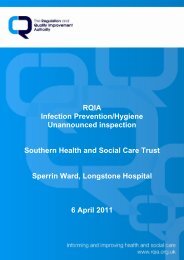Altnagelvin Hospital, Londonderry - 2 November 2011
Altnagelvin Hospital, Londonderry - 2 November 2011
Altnagelvin Hospital, Londonderry - 2 November 2011
Create successful ePaper yourself
Turn your PDF publications into a flip-book with our unique Google optimized e-Paper software.
RQIA<br />
Infection Prevention/Hygiene<br />
Unannounced inspection<br />
Western Health and Social Care Trust<br />
<strong>Altnagelvin</strong> <strong>Hospital</strong><br />
Brain Injury Unit<br />
2 <strong>November</strong> <strong>2011</strong><br />
[Type text]
Contents<br />
1.0 Inspection Summary 1<br />
2.0 Background Information to the Inspection Process 6<br />
3.0 Inspections 7<br />
4.0 Unannounced Inspections 8<br />
4.1 Onsite Inspection 8<br />
4.2 Feedback and Report of the findings 8<br />
5.0 Audit Tool 9<br />
6.0 Environment 11<br />
6.1 Cleaning 11<br />
6.2 Clutter 12<br />
6.3 Maintenance and Repair 13<br />
6.4 Fixture and Fittings 13<br />
6.5 Information 13<br />
7.0 Patient Linen 15<br />
7.1 Management of Linen 15<br />
8.0 Waste and Sharps 16<br />
8.1 Waste 16<br />
8.2 Sharps 16<br />
9.0 Patient Equipment 18<br />
10.0 Hygiene Factors 20<br />
11.0 Hygiene Practice 22<br />
12.0 Key Personnel and Information 24<br />
13.0 Summary of Recommendations 25<br />
14.0 Unannounced Inspection Flowchart 26<br />
15.0 RQIA Hygiene Team Escalation Policy Flowchart 28<br />
16.0 Action Plan 29
1.0 Inspection Summary<br />
An unannounced inspection was undertaken to the <strong>Altnagelvin</strong> <strong>Hospital</strong>, on<br />
the 2 <strong>November</strong> <strong>2011</strong>. The hospital was assessed against the Regional<br />
Healthcare Hygiene and Cleanliness standards and the following area was<br />
inspected:<br />
Spruce House - Brain Injury Unit<br />
Spruce House is a 24 bedded purpose built Neurodisability unit located within<br />
the grounds of <strong>Altnagelvin</strong> hospital. Opened in 2004, only part of the building<br />
is in use as just 18 beds have been commissioned. Beds are allocated<br />
equally among long stay, respite and slow stream rehabilitation.<br />
The building is well decorated and<br />
maintained; bedrooms are spacious<br />
which allows staff room to provide<br />
care to the patient unhindered<br />
(Picture 1).<br />
Picture 1 Spacious bed area<br />
All rooms have been fitted with ceiling<br />
tracking for handling equipment.<br />
Corridors are wide and contribute to a<br />
light bright environment. The unit has<br />
a Snoezelen room, with specialist<br />
multisensory equipment (Picture 2).<br />
Picture 2 Snoezelen, multisensory room<br />
1
Inspection Outcomes<br />
The results of the inspection showed compliance in all but two of the<br />
standards, for which staff are commended. The inspectors were impressed<br />
with staff commitment to providing a safe and caring environment for patients<br />
who require specialised one to one care. The two partial compliant standards<br />
in relation to safe handling of sharps and cleanliness and repair of patient<br />
equipment could easily become compliant if staff received update training or<br />
awareness sessions.<br />
The inspection resulted in14 recommendations for the Brain Injury Unit of<br />
<strong>Altnagelvin</strong> <strong>Hospital</strong>, a full list of recommendations is listed in Section 13.<br />
A detailed list of preliminary findings is forwarded to Western Health and<br />
Social Care Trust /organisation within 14 days of the inspection to enable<br />
early action on identified areas which have achieved non complaint scores.<br />
The draft report which includes the high level recommendations in a Quality<br />
Improvement Plan is forwarded within 28 days of the inspection for agreement<br />
and factual accuracy. The draft report is agreed and a completed action plan<br />
is returned to RQIA within 14 days from the date of issue. The detailed list of<br />
preliminary findings is available from RQIA on request.<br />
The final report and Quality Improvement Plan will be available on the RQIA<br />
website. Reports and action plans will be subject to performance<br />
management by the Health and Social Care Board and the Public Health<br />
Agency.<br />
Notable Practice<br />
The inspection identified the following areas of notable practice:<br />
An new waste streaming project was being rolled out in the unit to<br />
take into account recycling of paper waste<br />
The integrity and effective cleaning of surfaces and walls was<br />
promoted by the minimal use of paper labels and adhesive tape<br />
Inspectors noted a calm and relaxed atmosphere at ward level and<br />
the caring attitude of staff<br />
The RQIA inspection team would like to thank the staff at <strong>Altnagelvin</strong> <strong>Hospital</strong><br />
for their assistance during the inspection.<br />
2
The following tables give an overview of compliance scores noted in areas<br />
inspected by RQIA:<br />
Table 1 summarises the overall compliance levels achieved.<br />
Tables 2-7 summarise the individual tables for sections two to seven of the<br />
audit tool as this assists organisation to target areas that require more specific<br />
attention.<br />
Table 1<br />
Areas inspected<br />
General environment 89<br />
Patient linen 87<br />
Waste 88<br />
Sharps 79<br />
Equipment 84<br />
Hygiene factors 95<br />
Hygiene practices 91<br />
Average Score 88<br />
Table 2<br />
General environment<br />
Reception 98<br />
Corridors, stairs lift<br />
N/A<br />
Public toilets<br />
N/A<br />
Ward/department -<br />
general (communal)<br />
95<br />
Patient bed area 93<br />
Bathroom/washroom 84<br />
Toilet 93<br />
Clinical room/treatment<br />
room<br />
93<br />
Clean utility room 87<br />
Dirty utility room 86<br />
Domestic store 82<br />
Kitchen 98<br />
Equipment store 68<br />
Isolation 91<br />
General information 88<br />
Average Score 89<br />
Compliant:<br />
85% or above<br />
Partial Compliance: 76% to 84%<br />
Minimal Compliance: 75% or below<br />
3
Table 3<br />
Patient linen<br />
Storage of clean linen 83<br />
Storage of used linen 87<br />
Laundry facilities 90<br />
Average Score 87<br />
Table 4<br />
Waste and sharps<br />
Handling, segregation,<br />
storage, waste<br />
Availability, use, storage<br />
of sharps<br />
88<br />
79<br />
Table 5<br />
Patient equipment<br />
Patient equipment<br />
84<br />
Table 6<br />
Hygiene factors<br />
Availability and<br />
cleanliness of wash hand 94<br />
basin and consumables<br />
Availability of alcohol rub 100<br />
Availability of PPE 92<br />
Materials and equipment<br />
for cleaning<br />
93<br />
Average Score 95<br />
Compliant:<br />
85% or above<br />
Partial Compliance: 76% to 84%<br />
Minimal Compliance: 75% or below<br />
4
Table 7<br />
Hygiene practices<br />
Effective hand hygiene<br />
procedures<br />
100<br />
Safe handling and<br />
disposal of sharps<br />
100<br />
Effective use of PPE 91<br />
Correct use of isolation 87<br />
Effective cleaning of ward 69<br />
Staff uniform and work<br />
wear<br />
96<br />
Average Score 91<br />
Compliant:<br />
85% or above<br />
Partial Compliance: 76% to 84%<br />
Minimal Compliance: 75% or below<br />
5
2.0 Background Information to the Inspection Process<br />
RQIA’s infection prevention and hygiene team was established to undertake a<br />
rolling programme of unannounced inspections of acute hospitals. The<br />
Department of Health Social Service and Public Safety (DHSSPS)<br />
commitment to a programme of hygiene inspections was reaffirmed through<br />
the launch in 2010 of the revised and updated version of 'Changing the<br />
Culture' the strategic regional action plan for the prevention and control of<br />
healthcare-associated infections (HCAIs) in Northern Ireland.<br />
The aims of the inspection process are:<br />
to provide public assurance and to promote public trust and confidence<br />
to contribute to the prevention and control of HCAI<br />
to contribute to improvement in hygiene, cleanliness and infection<br />
prevention and control across health and social care in Northern Ireland<br />
In keeping with the aims of the RQIA, the team will adopt an open and<br />
transparent method for inspection, using standardised processes and<br />
documentation.<br />
6
3.0 Inspections<br />
The DHSSPS has devised Regional Healthcare Hygiene and Cleanliness<br />
standards. RQIA has revised its inspection processes to support the<br />
publication of the standards which were compiled by a regional steering group<br />
in consultation with service providers.<br />
RQIA's infection prevention/hygiene team have planned a three year<br />
programme which includes announced and unannounced inspections in acute<br />
and non-acute hospitals in Northern Ireland. This will assess compliance with<br />
the DHSSPS Regional Healthcare Hygiene and Cleanliness standards.<br />
The inspections will be undertaken in accordance with the four core activities<br />
outlined in the RQIA Corporate Strategy, these include:<br />
Improving care: we encourage and promote improvements in the safety<br />
and quality of services through the regulation and review of health and<br />
social care<br />
Informing the population: we publicly report on the safety, quality and<br />
availability of health and social care<br />
Safeguarding rights: we act to protect the rights of all people using<br />
health and social care services<br />
Influencing policy: we influence policy and standards in health and<br />
social care<br />
7
4.0 Unannounced Inspection Process<br />
Trusts receive no advanced notice of the onsite inspection. An email and<br />
telephone call will be made by the Chief Executive of RQIA or nominated<br />
person 30 minutes prior to the team arriving on site. The inspection flow chart<br />
is attached in Section 14.<br />
4.1 Onsite Inspection<br />
The inspection team was made up of two inspectors, from RQIA’s infection<br />
prevention/hygiene team. One inspector led the team and was responsible<br />
for guiding the team and ensuring they were in agreement about the findings<br />
reached. Membership of the inspection team is outlined in Section 12.<br />
The inspection of ward environments is carried out using the Regional<br />
Healthcare Hygiene and Cleanliness audit tool. The inspection process<br />
involves observation, discussion with staff, and review of some ward<br />
documentation.<br />
4.2 Feedback and Report of the Findings<br />
The process concludes with a feedback of key findings to trust<br />
representatives including examples of notable practice identified during the<br />
inspection. The details of trust representatives attending the feedback<br />
session is outlined in Section 12.<br />
The findings, report and follow up action will be in accordance with the<br />
Infection Prevention/ Hygiene Inspection Process (methodology, follow up and<br />
reporting).<br />
The infection prevention/hygiene team escalation process will be followed if<br />
inspectors/reviewers identify any serious concerns during the inspection<br />
(Section 15).<br />
A number of documents have been developed to support and explain the<br />
inspection process. This information is currently available on request and will<br />
be available in due course on the RQIA website.<br />
8
5.0 Audit Tool<br />
The audit tool used for the inspection is based on the Regional Healthcare<br />
Hygiene and Cleanliness standards. The standards incorporate the critical<br />
areas which were identified through a review of existing standards, guidance<br />
and audit tools (Appendix 2 of Regional Healthcare Hygiene and Cleanliness<br />
standards). The audit tool follows the format of the Regional Healthcare<br />
Hygiene and Cleanliness Standards and comprises of the following sections.<br />
1. Organisational Systems and Governance: policies and procedures in<br />
relation to key hygiene and cleanliness issues; communication of policies<br />
and procedures; roles and responsibilities for hygiene and cleanliness<br />
issues; internal monitoring arrangements; arrangements to address issues<br />
identified during internal monitoring; communication of internal monitoring<br />
results to staff<br />
This standard is not audited when carrying out unannounced<br />
inspections however the findings of the organisational system and<br />
governance at annual announced inspection will be, where<br />
applicable, confirmed at ward level.<br />
2. General Environment: cleanliness and state of repair of public areas;<br />
cleanliness and state of repair of ward/department infrastructure;<br />
cleanliness and state of repair of patient bed area; cleanliness and state<br />
of repair of toilets, bathrooms and washrooms; cleanliness and state of<br />
repair of ward/department facilities; availability and cleanliness of isolation<br />
facilities; provision of information for staff, patients and visitors<br />
3. Patient Linen: storage of clean linen; handling and storage of used linen;<br />
ward/department laundry facilities<br />
4. Waste and Sharps: waste handling; availability and storage of sharps<br />
containers<br />
5. Patient Equipment: cleanliness and state of repair of general patient<br />
equipment<br />
6. Hygiene Factors: hand wash facilities; alcohol hand rub; availability of<br />
personal protective equipment (PPE); availability of cleaning equipment<br />
and materials.<br />
7. Hygiene Practices: hand hygiene procedures; handling and disposal of<br />
sharps; use of PPE; use of isolation facilities and implementation of<br />
infection control procedures; cleaning of ward/department; staff uniform<br />
and work wear<br />
9
Level of Compliance<br />
Percentage scores can be allocated a level of compliance using the<br />
compliance categories below. The categories are allocated as follows:<br />
Compliant<br />
85% or above<br />
Partial compliance 76 to 84%<br />
Minimal compliance 75% or below<br />
Each section within the audit tool will receive an individual and an overall<br />
score, to identify areas of partial or minimal compliance to ensure that the<br />
appropriate action is taken.<br />
10
6.0 Environment<br />
STANDARD 2.0<br />
GENERAL ENVIRONMENT<br />
Cleanliness and state of repair of public areas; cleanliness and<br />
state of repair of ward/department infrastructure; cleanliness and<br />
state of repair of patient bed area; cleanliness and state of repair<br />
of toilets, bathrooms and washrooms; cleanliness and state of<br />
repair of ward/department facilities; availability and cleanliness of<br />
isolation facilities; provision of information for staff, patients and<br />
visitors.<br />
General environment<br />
Reception 98<br />
Corridors, stairs lift<br />
N/A<br />
Public toilets<br />
N/A<br />
Ward/department -<br />
general (communal)<br />
95<br />
Patient bed area 93<br />
Bathroom/washroom 84<br />
Toilet 93<br />
Clinical room/treatment<br />
room<br />
93<br />
Clean utility room 87<br />
Dirty utility room 86<br />
Domestic store 82<br />
Kitchen 98<br />
Equipment store 68<br />
Isolation 91<br />
General information 88<br />
Average Score 89<br />
The above table outlines the findings in relation to the general environment of<br />
the facility inspected. Compliance was demonstrated in the majority of areas<br />
within the ward with the regional specifications for cleaning standards. The<br />
findings in respect of the general environment are detailed in the following<br />
sections. This standard achieved an overall compliant score, the only section<br />
within the standard with a minimally compliant score was the equipment store.<br />
6.1 Cleaning<br />
The equipment store was cluttered and had not been cleaned for some time.<br />
There was debris and balls of fluff on the floor, the skirting was stained and<br />
there were cobwebs around the window and the tops of the wall.<br />
In relation to the general environment more detailed cleaning is required when<br />
cleaning the underside of patient bedside tables, toilet brush holders and<br />
some walls, which were stained. There was a build up of dust on the air vent<br />
11
in a bathroom and surfaces in the dirty utility room. It was also noted in the<br />
dirty utility room that the inside of the sluice hopper was stained and the<br />
shower chairs, which were stored in the dirty utility room, had rust damage,<br />
paper labels and adhesive residue on the framework.<br />
A single room where a patient was being nursed under isolation precautions<br />
was inspected. Several cleaning issues were identified. There were splashes<br />
and stains on the wall below the soap and towel dispensers and on the wall<br />
behind the patient’s bed. The patient bedside table was being used as a work<br />
surface and storage area for food supplements; the underside of the bedside<br />
table was stained. There was a build up of debris and dust behind the door<br />
and the waste bins. In the en-suite, the toilet brush holder was dusty, spare<br />
toilet rolls were stored on top of the cistern and the patient’s duvet cover was<br />
draped over the hand washing sink and was trailing on the floor (Picture 3).<br />
6.2 Clutter<br />
Picture 3 Bed clothes stored on hand wash sink<br />
The only section which was minimally compliant<br />
was the equipment store; the room was very<br />
cluttered with IV stands and large patient chairs<br />
making the room inaccessible (Picture 4).<br />
There was also a stale odour present, which<br />
may be coming from a hand washing sink in the<br />
room. The sink was not accessible due to the<br />
clutter, staff confirmed that the water was not<br />
being run regularly. Staff should liaise with the<br />
Estates department regarding the requirements<br />
to running water in line with the trust legionella<br />
policy.<br />
Picture 4 Cluttered equipment store<br />
12
The main patient areas were generally clutter free, however the inspectors did<br />
note that there was little storage space for patients personal belongings. In<br />
one room patients’ clothes and personal items were stored on the floor.<br />
The clean utility room was cluttered, boxes of stock were being stored on work<br />
surfaces. Clutter can be a barrier to effective regular cleaning.<br />
6.3 Maintenance and Repair<br />
This is a new building and has been<br />
maintained in good repair. However<br />
the inspectors did observe the vinyl<br />
flooring behind the washing machine<br />
in the laundry room and under the<br />
sluice sink in the domestic store was<br />
split and lifting and in need of repair<br />
(Picture 5).<br />
Picture 5 Damage to vinyl flooring in domestic store<br />
6.4 Fixtures and fittings<br />
The fixtures and fitting within the unit were in good condition, the only area<br />
which required attention was in relation to sanitary fittings; the caps on hinges<br />
of the toilet seat in room GN030 and the cap on the single tap in the isolation<br />
room were missing.<br />
6.5 Information<br />
Cleaning schedules for both domestic and nursing staff were available,<br />
however the schedules for nursing staff require more detail. When questioned<br />
nursing staff did show they had been piloting a new daily joint nursing and<br />
domestic cleaning sheet for the patient bed area which had to be signed off<br />
daily. The record sheet the inspectors observed in the bedroom had not been<br />
completed by domestic staff and had not been consistently completed by<br />
nursing staff.<br />
Colour coded posters for cleaning equipment were not available for nursing<br />
staff; staff addressed this issue at the time of inspection. The inspectors did<br />
not observe information leaflets on Clostridium difficle.<br />
13
Recommendations<br />
1. The trust should ensure that the systems and processes in place<br />
for environmental cleaning, provide the necessary assurance that<br />
cleaning is carried out effectively, and that all staff are aware of<br />
their responsibilities.<br />
2. The healthcare environment should be repaired and maintained,<br />
and damaged fixtures and fittings replaced to maintain public<br />
confidence and to help reduce the risk of the spread of infection.<br />
3. Staff should review the use of the equipment store and clean utility<br />
room and the level of stock required in the unit with a view to<br />
improving storage and maintaining a clutter free environment.<br />
4. Detailed nursing cleaning schedules should be further developed.<br />
14
7.0 Patient Linen<br />
STANDARD 3.0<br />
PATIENT LINEN<br />
Storage of clean linen; handling and storage of used linen; ward/<br />
department laundry facilities.<br />
7.1 Management of Linen<br />
Linen<br />
Storage of clean linen 83<br />
Storage of used linen 87<br />
Laundry facilities 90<br />
Average Score 87<br />
This standard achieved an overall compliance score, two of the three sections<br />
were compliant. The section on the storage of clean linen was partially<br />
compliant. The ward had a good, well laid out linen store however the<br />
wooden shelving required sealing and paper labels should be removed. The<br />
store had no natural light and the light bulb was not working. In a patient’s<br />
bedroom the inspectors observed clean linen was being stored on the window<br />
sill to encourage and support independence for a patient who makes their<br />
own bed. If linen is to be stored in bedrooms, a suitable cupboard or storage<br />
unit should be supplied.<br />
With regard to the section on handling and storage of used linen, a member of<br />
staff was observed carrying a bag of used linen to the dirty utility room. The<br />
member of staff was not wearing a disposable apron. When handling used<br />
linen staff should ensure they wear personal protective equipment (PPE) and<br />
that the used linen trolley is taken to the bedside for the immediate disposal of<br />
used linen.<br />
A working laundry had been installed in the ward for patient use; staff advised<br />
that this was not used very often. There was debris in the ceiling light fittings,<br />
one of the light bulbs was not working and as stated in the previous standard<br />
the vinyl flooring behind the washing machine was damaged.<br />
Recommendations<br />
5. The trust should ensure the correct storage of clean linen in a<br />
designated area which is fit for purpose<br />
6. Systems should be in place to ensure that staff adhere to regional<br />
guidance and trust policies and that staff knowledge is kept up to<br />
date in respect of handling and storage of linen.<br />
15
8.0 Waste and Sharps<br />
STANDARD 4.0<br />
WASTE AND SHARPS<br />
Waste: Effectiveness of arrangements for handling, segregation,<br />
storage and disposal of waste on ward/ department<br />
Sharps: Availability, use and storage of sharps containers on<br />
ward/ department<br />
Waste and sharps<br />
Handling, segregation,<br />
storage, waste<br />
Availability, use, storage<br />
of sharps<br />
88<br />
79<br />
8.1 Waste<br />
The ward achieved a compliance score in the management of waste. The<br />
inspection evidenced that there were arrangements in place for the handling<br />
and storage of waste in line with local and regional guidance.<br />
Some issues were identified in respect of the correct segregation of waste.<br />
There was no black lidded burn bin for the disposal of pharmaceutical waste<br />
and medicine bottles were disposed off inappropriately into a magpie box.<br />
There was no household waste bin available in the dirty utility room, and the<br />
underside of a lid on the waste bin in a bedroom and at the nurses’ station<br />
was rusty.<br />
8.2 Sharps<br />
A partially compliant score was achieved in this standard. Sharps boxes in<br />
use conformed to BS7320 (1990)/UN9291 standard and were assembled<br />
correctly.<br />
The issues identified were in relation to the temporary closure mechanism on<br />
the sharps boxes which were not in place. Also the integrated sharps trays<br />
which are used when assembling equipment to carry out a clinical procedure<br />
were stained.<br />
16
Recommendations<br />
7. Systems and process should be in place to ensure that staff<br />
comply with the trust policy on the segregation and safe disposal<br />
of waste.<br />
8. The trust should monitor the implementation of its policies and<br />
procedures in respect of the management of waste and sharps to<br />
ensure that safe and appropriate practice is in place.<br />
17
9.0 Patient Equipment<br />
STANDARD 5.0<br />
PATIENT EQUIPMENT<br />
Cleanliness and state of repair of general patient equipment.<br />
Patient equipment<br />
Patient equipment<br />
84<br />
A partial compliance score was achieved in this standard. In general the<br />
equipment at the patient’s bedside was clean and in good repair. Trigger tape<br />
was used extensively to indicate and record when cleaning had taken place.<br />
Care should be taken to ensure that stored equipment which has been<br />
cleaned is checked at regular intervals, as stored equipment was very dusty<br />
and the trigger tape was dated July <strong>2011</strong>.<br />
A commode in the dirty utility room also had trigger tape, indicating it had<br />
been cleaned that morning; on inspection the underside was found to be<br />
stained and the vinyl of the cushion was split. Damaged surfaces can not be<br />
effectively cleaned and such items should be reported for replacement.<br />
Validation audits should be carried out to ensure the standard of cleaning<br />
required is being achieved on all equipment<br />
Other pieces of equipment which need more attention to detail when cleaning<br />
include the resuscitation trolley which had adhesive residue on the work<br />
surface. The leads of the ECG machine were grubby and the underside of the<br />
drugs and dressing trolleys was stained and had tape and plastic bag residue<br />
on the underside of the frame. The drinking water dispenser in the reception<br />
had a white limescale deposit; this was cleaned by staff during the inspection.<br />
Inspectors observed that the box of<br />
the Laerdal Pocket Mask on top of<br />
the resuscitation trolley was open<br />
and that the mask was exposed<br />
(Picture 6). In the drawer of the<br />
trolley two laryngoscope handles had<br />
blades attached, sterile single use<br />
items should remain in the original<br />
packaging until ready for use for<br />
traceability purpose.<br />
Picture 6 Exposed Laerdal mask<br />
18
Recommendations<br />
9 The trust and individual staff have a collective responsibility to<br />
ensure that patient equipment is clean, stored correctly and in good<br />
repair.<br />
10 Systems and processes should be in place to assure that staff<br />
knowledge and practice is kept up to date regarding the<br />
decontamination of patient equipment.<br />
19
10.0 Hygiene Factors<br />
STANDARD 6.0<br />
HYGIENE FACTORS<br />
Hand wash facilities; alcohol hand rub; availability of PPE;<br />
availability of cleaning equipment and materials.<br />
Hygiene factors<br />
Availability and<br />
cleanliness of wash hand<br />
94<br />
basin and consumables<br />
Availability of alcohol rub 100<br />
Availability of PPE 92<br />
Materials and equipment<br />
for cleaning<br />
93<br />
Average Score 95<br />
Staff are to be commended for achieving a compliance score in each of the<br />
sections in this standard, with the section on availability of alcohol rub<br />
achieving full compliance.<br />
In the section on availability and cleanliness of hand wash sinks and<br />
consumables the inspectors noted the seal behind the hand wash sink in the<br />
nurses’ work station was dirty and that the soap dispenser in the clean utility<br />
room was missing form the wall. The waste disposal room had been fitted<br />
with a hand washing sink, a good initiative, however access to the sink was<br />
blocked by filled soiled linen bags.<br />
With regard to the availability of PPE, a trolley had been positioned outside<br />
each isolation room to hold boxes of gloves and rolls of disposable aprons.<br />
The trolleys were cluttered and untidy with additional items and paper work.<br />
In the fourth section, material and equipment for cleaning, the door to the<br />
domestic store was unlocked therefore chemicals were not stored in line with<br />
Control of Substances Hazardous to Health (COSHH) regulations. The<br />
inspectors also noted that the chrome extension tubes for the vacuum cleaner<br />
had been repaired with adhesive tape.<br />
20
Recommendations<br />
11 The trust should ensure that hand washing sinks and consumables<br />
are available, clean, and in a good state of repair.<br />
12 The trust should ensure that all cleaning products are stored in a<br />
locked cupboard, in accordance with COSHH regulations.<br />
21
11.0 Hygiene Practices<br />
STANDARD 7.0<br />
HYGIENE PRACTICES<br />
Hand hygiene procedures; handling and disposal of sharps; use<br />
of PPE; use of isolation facilities and implementation of infection<br />
control procedures; cleaning of ward/ department; staff uniform<br />
and work wear.<br />
Hygiene practices<br />
Effective hand hygiene<br />
procedures<br />
100<br />
Safe handling and<br />
disposal of sharps<br />
100<br />
Effective use of PPE 91<br />
Correct use of isolation 87<br />
Effective cleaning of ward 69<br />
Staff uniform and work<br />
wear<br />
96<br />
Average Score 91<br />
Five out of the six sections achieved compliance. Two of those sections,<br />
hand hygiene procedures and safe disposal of sharps, were fully compliant.<br />
In the section on effective cleaning of the ward, it was disappointing to note a<br />
minimally compliant score. The inspectors noted that on questioning nursing<br />
staff in both the practical application on how to make up disinfectants and<br />
correct disinfectant dilution rates, staff needed to update their knowledge.<br />
Information posters on correct dilution rates of disinfectants for staff to<br />
reference were not available, however, copies of dilution rate charts were<br />
obtained and displayed by the end of the inspection.<br />
The inspectors were told by a member of domestic staff that Actichlor Plus, a<br />
disinfectant with detergent, was not used as part of the daily cleaning process<br />
for an isolation room; only detergent was used. Actichlor Plus was only used<br />
when the room was empty and being terminally cleaned. This practice should<br />
be clarified with the domestic services manager and infection prevention and<br />
control staff to ensure that this practice is in accordance with the local policy<br />
and procedure.<br />
In relation to the correct use of isolation a review of patients’ nursing notes<br />
with known infections was carried out. Staff should ensure that care<br />
pathways are fully completed and reviewed within the set timescale. In one of<br />
the patient’s nursing notes, a care plan was also available, this enabled staff<br />
to record daily in the progress notes. In the other notes it was observed that<br />
nursing interventions that had occurred on the day of the inspection, in<br />
relation to the on going care for their infection, had not always been recorded.<br />
22
Recommendations<br />
13 Systems and processes should be in place to assure that staff<br />
knowledge and practice is kept up to date regarding the use of<br />
disinfectants.<br />
14 Staff should ensure that care pathways are fully completed and<br />
reviewed within the set timescale.<br />
23
12.0 Key Personnel and Information<br />
Members of the RQIA inspection team<br />
Mrs E Colgan<br />
Mrs M Keating<br />
- Senior Officer Infection Prevention/Hygiene Team<br />
- Inspector Infection Prevention/Hygiene Team<br />
Trust representatives attending the feedback session<br />
The key findings of the inspection were outlined to the following trust<br />
representatives:<br />
Ms A. Witherow - Assistant Director of Nursing<br />
Mr S Gibson - Head of Operations and Maintenance<br />
Ms M Kelly - Head of Support Services<br />
Mr M Quinn - Head of Service Adult Disability Services/Lead Nurse<br />
Ms E England - Lead Nurse/General Manager Cancer Services<br />
Ms S Gormley - Support Services Manager<br />
Ms S Glenn - Ward Manager, Ward 43 Sperrin Ward<br />
Ms C Brown - Ward Manager, Spruce House<br />
Ms U Cardin - Ward Manager, Sperrin Unit<br />
Ms Y Black - Assistant Manager Support Services<br />
Supporting documentation<br />
A number of documents have been developed to support the inspection<br />
process, these are:<br />
Infection Prevention/Hygiene Inspection Process (methodology, follow<br />
up and reporting)<br />
Infection Prevention/Hygiene Team Inspection Protocol (this document<br />
contains details on how inspections are carried out and the composition<br />
of the teams)<br />
Infection Prevention/Hygiene Team Escalation Policy<br />
RQIA Policy and Procedure for Use and Storage of Digital Images<br />
This information is currently available on request and will be available in due<br />
course on the RQIA website.<br />
24
13.0 Summary of Recommendations<br />
1. The trust should ensure that the systems and processes in place<br />
for environmental cleaning, provide the necessary assurance that<br />
cleaning is carried out effectively, and that all staff are aware of<br />
their responsibilities.<br />
2. The healthcare environment should be repaired and maintained,<br />
and damaged fixtures and fittings replaced to maintain public<br />
confidence and to help reduce the risk of the spread of infection<br />
3. Staff should review the use of the equipment store and clean utility<br />
room and the level of stock required in the unit with a view to<br />
improving storage and maintaining a clutter free environment<br />
4. Detailed nursing cleaning schedules should be further developed.<br />
5. The Trust should ensure the correct storage of clean linen in a<br />
designated area which is fit for purpose<br />
6. Systems should be in place to ensure that staff adhere to regional<br />
guidance and trust policies and that staff knowledge is kept up to<br />
date in respect of handling and storage of linen.<br />
7. Systems and process should be in place to ensure that staff<br />
comply with the trust policy on the segregation and safe disposal<br />
of waste.<br />
8. The trust should monitor the implementation of its policies and<br />
procedures in respect of the management of waste and sharps to<br />
ensure that safe and appropriate practice is in place.<br />
9. The trust and individual staff have a collective responsibility to<br />
ensure that patient equipment is clean, stored correctly and in good<br />
repair.<br />
10. Systems and processes should be in place to assure that staff<br />
knowledge and practice is kept up to date regarding the<br />
decontamination of patient equipment.<br />
11. The trust should ensure that hand washing sinks consumables are<br />
available clean, and in a good state of repair.<br />
12. The trust should ensure that all cleaning products are stored in<br />
locked cupboard, in accordance with COSHH regulations.<br />
13. Systems and processes should be in place to assure that staff<br />
knowledge and practice is kept up to date regarding the use of<br />
disinfectants.<br />
25
Reporting & Re-Audit<br />
Episode of Inspection<br />
Plan Programme<br />
14.0 Unannounced Inspection Flowchart<br />
Environmental Scan:<br />
Stakeholders & External<br />
Information<br />
Plan<br />
Programme<br />
Consider:<br />
Areas of Non-Compliance<br />
Infection Rates<br />
Trust Information<br />
RQIA Hygiene Team<br />
Prioritise Themes & Areas for Core Inspections<br />
Prior to Inspection Year<br />
Balance Programme<br />
January/February<br />
Schedule Inspections<br />
Prior to Inspection<br />
Identify & Prepare Inspection Team<br />
Day of Inspection<br />
Inform Trust<br />
Day of Inspection<br />
Carry out Inspection<br />
A<br />
Is there immediate risk<br />
requiring formal escalation?<br />
NO<br />
YES<br />
Invoke<br />
RQIA<br />
IPHTeam<br />
Escalation<br />
Process<br />
Day of Inspection<br />
Feedback Session with Trust<br />
14 days after<br />
Inspection<br />
28 days after<br />
Inspection<br />
Preliminary Findings<br />
disseminated to Trust<br />
Draft Report<br />
disseminated to Trust<br />
NO<br />
Does assessment of<br />
the findings require<br />
escalation?<br />
YES<br />
Invoke<br />
RQIA<br />
IPHTeam<br />
Escalation<br />
Process<br />
A<br />
14 days later<br />
Signed Action Plan<br />
received from Trust<br />
Within 0-3 months<br />
Is a Follow-Up required?<br />
Based on Risk Assessment/key<br />
indicators or Unsatisfactory Quality<br />
Improvement Plan (QIP)?<br />
YES<br />
Invoke<br />
Follow-Up<br />
Protocol<br />
Process enables<br />
only 1 Follow-Up<br />
NO<br />
Open Report published to Website<br />
YES<br />
Is Follow-Up<br />
satisfactory?<br />
NO<br />
DHSSPS/HSC<br />
Board/PHA<br />
PHA<br />
1
15.0 Escalation Process<br />
RQIA Hygiene Team: Escalation Process<br />
B<br />
RQIA IPH<br />
Team<br />
Escalation<br />
Process<br />
Concern / Allegation / Disclosure<br />
Inform Team Leader / Head of Programme<br />
MINOR/MODERATE<br />
Has the risk been<br />
assessed as Minor,<br />
Moderate or Major?<br />
MAJOR<br />
Inform key contact and keep a record<br />
Inform appropriate RQIA Director and Chief Executive<br />
Record in final report<br />
Inform Trust / Establishment / Agency<br />
and request action plan<br />
Notify Chairperson and<br />
Board Members<br />
Inform other establishments as appropriate:<br />
E.g.: DHSSPS, RRT, HSC Board, PHA,<br />
HSENI<br />
Seek assurance on implementation of actions<br />
Take necessary action:<br />
E.g.: Follow-Up Inspection<br />
2
16.0 Action Plan<br />
Reference<br />
number<br />
Recommendations<br />
1. The trust should ensure that the systems and<br />
processes in place for environmental cleaning, provide<br />
the necessary assurance that cleaning is carried out<br />
effectively, and that all staff are aware of their<br />
responsibilities.<br />
Designated<br />
department<br />
Support<br />
Services<br />
Nursing<br />
Action required<br />
The Trust has cleaning programmes in<br />
place and support staff have all receive<br />
training on BICS. Support Services Team<br />
leaders carry out their own quality control<br />
audits which are based on the EC audits<br />
check list<br />
Cleaning schedules for patient equipment<br />
are in development and will be re-issued<br />
January 2012<br />
Date for<br />
completion/<br />
timescale<br />
January 2012<br />
2. The healthcare environment should be repaired and<br />
maintained, and damaged fixtures and fittings<br />
replaced to maintain public confidence and to help<br />
reduce the risk of the spread of infection.<br />
Estates<br />
Defects to be reported to Estates Help<br />
Desk.<br />
Environmental Cleanliness audits to be<br />
monitored to assess areas needing<br />
attention. Backlog Maintenance Funding<br />
to be secured from General Capital to<br />
address audit issues<br />
Ongoing<br />
3. Staff should review the use of the equipment store and<br />
clean utility room and the level of stock required in the<br />
unit with a view to improving storage and maintaining<br />
a clutter free environment.<br />
Estates<br />
Nursing<br />
The Productive ward series will be<br />
implemented from February onwards<br />
which using lean methodologies will help<br />
to bring focus to the aspect of stock<br />
management<br />
Work is also on-going in relation to the<br />
development of a de-clutter programme<br />
for staff to have access to regular<br />
disposal opportunities etc.<br />
Early 2012<br />
3
Reference<br />
number<br />
Recommendations<br />
4. Detailed nursing cleaning schedules should be further<br />
developed.<br />
Designated<br />
department<br />
Nursing<br />
Action required<br />
Work has commenced to develop a<br />
nursing cleaning template and this will<br />
also be included in the EC audits from<br />
February onwards<br />
Date for<br />
completion/<br />
timescale<br />
January 2012<br />
5. The Trust should ensure the correct storage of clean<br />
linen in a designated area which is fit for purpose.<br />
Nursing<br />
Training work shops are being scheduled<br />
for staff Jan- March and this will be<br />
addressed in the programme.<br />
Ward managers have been asked to<br />
identify where a problem with linen<br />
storage exists and to raise through their<br />
governance and estates meetings.<br />
On going<br />
6. Systems should be in place to ensure that staff adhere<br />
to regional guidance and trust policies and that staff<br />
knowledge is kept up to date in respect of handling<br />
and storage of linen.<br />
Nursing<br />
Support<br />
services<br />
Guidance for staff on the correct<br />
management will be included in the<br />
training scheduled for jan-march 2012.<br />
Jan- March<br />
2012<br />
7. Systems and process should be in place to ensure<br />
that staff comply with the trust policy on the<br />
segregation and safe disposal of waste.<br />
Estates<br />
Annual Sharps Safety Audit <strong>Altnagelvin</strong><br />
and Erne recently completed by Daniels<br />
Heathcare, findings due to be circulated<br />
by 20 th December <strong>2011</strong>.<br />
December<br />
<strong>2011</strong><br />
8 The trust should monitor the implementation of its<br />
policies and procedures in respect of the management<br />
of waste and sharps to ensure that safe and<br />
appropriate practice is in place.<br />
Estates As above As above<br />
4
Reference<br />
number<br />
Recommendations<br />
9 The trust and individual staff have a collective<br />
responsibility to ensure that patient equipment is<br />
clean, stored correctly and in good repair.<br />
Designated<br />
department<br />
Nursing<br />
Estates<br />
services<br />
Action required<br />
The Trust has an equipment /<br />
decontamination policy and all directors<br />
have been written to advising them of the<br />
measures they must take to ensure that<br />
this is followed.<br />
This is part of the equipment controls<br />
assurance standard and will be monitored<br />
again in spring 23012<br />
Date for<br />
completion/<br />
timescale<br />
Ongoing<br />
10 Systems and processes should be in place to assure<br />
that staff knowledge and practice is kept up to date<br />
regarding the decontamination of patient equipment.<br />
Nursing<br />
IPC Mandatory Training Slides updated<br />
All Ward Managers have received a<br />
reminder email with insructions for how to<br />
access disinfectant training DVD.<br />
Actichlor disinfectant representative to<br />
provide training ward to ward within the<br />
next month.<br />
In addition a laminated information card<br />
will be developed for staff reference.<br />
Commenced<br />
and on-going<br />
11 The trust should ensure that hand washing sinks<br />
consumables are available, clean, and in a good state<br />
of repair.<br />
Support<br />
Services<br />
The cleaning schedules includes the<br />
cleaning/replenishing of hand towels,<br />
toilet rolls and hand washing dispensers<br />
On-going<br />
12 The trust should ensure that all cleaning products<br />
are stored in locked cupboard, in accordance with<br />
COSHH regulations.<br />
Support<br />
Services<br />
Support Services staff receive training on<br />
COSHH as part of their induction. Also<br />
BICS training incorporates COSHH<br />
training. Support Services Team Leaders<br />
to monitor as part of their supervisory<br />
duties.<br />
On-going<br />
5
Reference<br />
number<br />
Recommendations<br />
13 Systems and processes should be in place to assure<br />
that staff knowledge and practice is kept up to date<br />
regarding the use of disinfectants.<br />
Designated<br />
department<br />
Nursing and<br />
Support<br />
Services<br />
Action required<br />
As for reference number 10<br />
Support Services induction provides basic<br />
training for all new staff. The BICS<br />
training programme incorporates dilution<br />
rates for all cleaning<br />
products/disinfectants used.<br />
Date for<br />
completion/<br />
timescale<br />
On-going<br />
14 Staff should ensure that care pathways are fully<br />
completed and reviewed within the set timescale.<br />
Nursing<br />
A Trust Nursing Record Keeping Project<br />
is commencing February <strong>2011</strong> which<br />
includes a new nursing document and<br />
audit processes.<br />
The matter of care planning and the<br />
review of care plans will be central to this<br />
project.<br />
A facilitator has been appointed to take<br />
this work forward for the incoming year<br />
February 2012<br />
6


